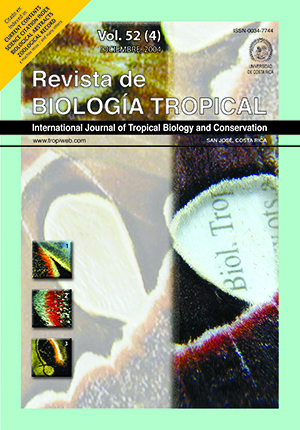Abstract
The composition of the mesozooplanktonic community was studied in the Punta Morales estuary, Gulf of Nicoya, Pacific coast of Costa Rica, during 1997. Oblique plankton hauls were performed during high and low tide using a 280 μm mesh screen net equipped with a flowmeter. The community was characterized by holoplanktonic and meroplanktonic organisms. For the holoplanktonic community, the main groups were copepods (80%) and chaetognaths (16%). The most abundant species were the copepods Acartia lilljeborgii and Paracalanus parvus. A. lilljeborgii is a typical estuarine species that maintains high populations in estuarine systems. Meroplankton was represented mainly by crustacean larvae (66%), and icthyoplankton (18%). The dominance of crustacean larvae and icthyoplankton is an evidence of the ecological importance of the Punta Morales zoneReferences
Álvarez-Silva, C., M.G. Guadalupe Miranda Arce & G. De Lara-Isassi. 2003. Familia Pontellidae (Crustacea:
Copepoda) en la Bahía La Ventosa, Oaxaca, México: Sistemática y ecología básica. Rev. Biol. Trop. 51:
-742.
Björnberg, T.K. 1981. Copepoda, p. 578-679. In D. Boltovskoy (ed.). Atlas de Zooplancton del Atlántico Sudoccidental y métodos de trabajo con el zooplancton marino. INIDEP, Mar del Plata, Argentina.
Boltovskoy, D. 1981. Atlas del zooplancton del Atlántico Sudoccidental y metodología de trabajo con el zooplancton marino. INIDEP, Mar del Plata, Argentina. 933 p.
Brugnoli, E. 1999. Factores abióticos y bióticos que regulan la estructura y dinámica de la comunidad
fitoplánctica en la zona de Punta Morales, Golfo de Nicoya. Tesis de maestría, Universidad de Costa
Rica, San José, Costa Rica.
Campos, A. & E. Suarez. 1994. Copépodos pelágicos del Golfo de México y Mar Caribe. I. Biología y sistemática. Centro de Investigaciones de Quintana Roo, México. 353 p.
Cronin, T. 1982. Estuarine retention of larva of the crab Rhithropanopeus harrisii. Estuar. Coast. Shelf. Sci. 15: 207-220.
Chisholm, L. & J.C. Roff. 1990. Abundances, growth rates, and production of tropical neritic copepods of
Kingston, Jamaica. Mar. Biol. 106: 79-89.
Díaz-Ferguson, E & J.A. Vargas. 2001. Abundance of Petrolisthes armatus (Crustacea: Porcellanidae) in a
tropical estuarine intertidal rocky beach, Gulf of Nicoya estuary, Costa Rica. Rev. Biol. Trop. 49: 97-101.
Dittel, A., C.E. Epifanio & J.B. Chavarría.1985. Population biology of the Portunid crab Callinectes arcuatus
Orway in the Gulf of Nicoya, Costa Rica, Central America. Estuar. Coast. Shelf Sci. 20: 593-602.
Dittel, A. & C.E. Epifanio. 1990. Seasonal and tidal abundance of crab larvae in a tropical mangrove system, Gulf of Nicoya, Costa Rica. Mar. Ecol. Progr. Ser. 65: 25-34.
Dittel, A., C.E. Epifanio & O. Lizano. 1991. Flux of Crab Larvae in Mangrove Creek in the Gulf of Nicoya,
Costa Rica. Estuar. Coast. Shelf Sci. 32: 129-140.
Dudley, P.C. 1986. Aspects of general body shape and development in Copepoda. Syllogues 59: 7-25.
Epifanio, C.E. & A. Dittel. 1982. Comparison of dispersal of crab larvae in Delaware Bay (USA), and the
Gulf of Nicoya, Central America, p. 447-487. In V. Kennedy (ed.) Estuarine Comparisons. Academic.
New York.
Hopcroft, R., J.C. Roff & D. Lombard. 1998. Production of tropical copepods in Kingston Harbour, Jamaica:
the importance of small species. Mar. Biol. 130: 593-604.
Hossfel, B. 1996. Distribution and biomass of arrow worms (Chaetognata) in Golfo de Nicoya and Golfo Dulce, Costa Rica. Rev. Biol. Trop. 44: 157-172.
Kimmerer, W. & A.D. McKinnon. 1987a. Zooplankton in a marine bay. I. Horizontal distribution used to
estimate net population growth rate. Mar. Ecol. Prog. Ser. 41: 43-52.
Kimmerer, W. & A.D. McKinnon. 1987b. Zooplankton in marine bay. II. Vertical migration to maintain horizontal distributions. Mar. Ecol. Progr. Ser. 41: 53-60.
Klemas, V., S. Ackleson, M. Murillo & J.A. Vargas. 1981. Water quality assement of Golfo de Nicoya, Costa
Rica. Progress report of the 1980-1981. International Sea Grant Program, University of Delaware, College
of Marine Studies, Newark. 1096 p.
Longhurst, A. 1985. The structure and evolution of plankton communities. Progr. Oceanogr. 15: 1-35.
Lizano O.G. & E.J. Alfaro. 2004. Algunas características de las corrientes marinas en el Golfo de Nicoya,
Costa Rica. Rev. Biol. Trop. 52 (Suppl. 2): 77-94.
Morales, A. & J.A. Vargas. 1995. Especies comunes de copépodos (Crustacea: Copepoda) pelágicos del
Golfo de Nicoya, Costa Rica. Rev. Biol. Trop. 43: 207- 218.
Morales, A. 1996. Checklist of copepods from Gulf of Nicoya, Coronado Bay and Golfo Dulce, Pacific coast of Costa Rica, with comments on their distribution. Rev. Biol. Trop. 44: 103-113.
Morales-Ramírez, A. 2001. Biodiversidad marina en Costa Rica, los microcrustáceos: Subclase Copepoda (Crustacea: Maxillopoda). Rev. Biol. Trop. 49: 115-133.
Newell, G. & R. Newell. 1975. Marine Plankton. A practical guide. Hutchinson, London. 221 p.
Paffenhöfer, G. & D. Stearns. 1988. Why is Acartia tonsa (Copepoda: Calanoida) restricted to nearshore environments? Mar. Ecol. Progr. Ser. 42: 33-38.
Palomares-García, R. & J. Gómez-Gutierrez. 1996. Copepod community structure at Bahia Magdalena,
Mexico during El Niño 1983-1984. Estuar. Coast. Shelf Sci. 43: 583-595.
Peterson, C.L. 1958. The physical oceanography of the Gulf of Nicoya, Costa Rica, a tropical estuary. Bull.
Inter. Ame. Trop. Tuna Comm. 3: 139-216.
Ramírez, A., W.A. Szelistowski & M. López. 1989. Spawning pattern and larval recruitment in Gulf of
Nicoya anchovies (Pisces: Engrulidae). Rev. Biol. Trop. 37: 55-62.
Raymont, J. 1983. Plankton and productivity in the oceans. Vol. 2. Zooplankton. Pergamont. Oxford. 824 p.
Suárez-Morales, E. & R. Gasca. 1989. Copépodos calanoides epidemiológicos del Domo de Costa Rica (Junio- Agosto, 1982). Cien. Mar. 15: 89-102.
Suárez-Morales, E. 1995. Copépodos. Con qué se comen? Inf. Cient. Tecn. México. 17: 18-21.
Smith, D. 1977. A guide to marine coastal plankton and marine invertebrate larvae. Kendall & Hunt.
EUA.140 p.
Todd, C. & M. Laverack. 1991. Coastal marine zooplankton. A practical manual for students. Cambridge.
p.
Voohris, A., D. Epifanio, C.E. Maurer, A. Dittel & J. Vargas. 1983. The estuarine character of the Gulf of Nicoya, an embayment on the Pacific Coast of Central America. Hydrobiology 99: 225-237.
Wooldridge, T. & T. Erasmus. 1980. Utilization of tidal currents by estuarine zooplankton. Estuar. Coast. Mar. Sci. 2:107-114.
Comments

This work is licensed under a Creative Commons Attribution 4.0 International License.
Copyright (c) 2004 Revista de Biología Tropical


